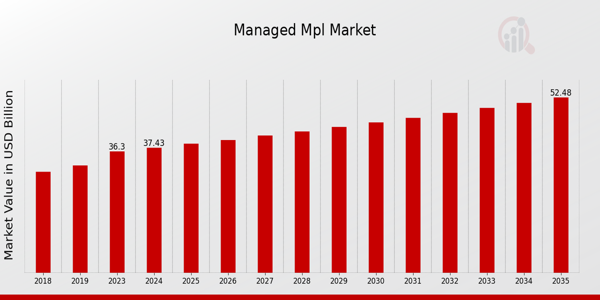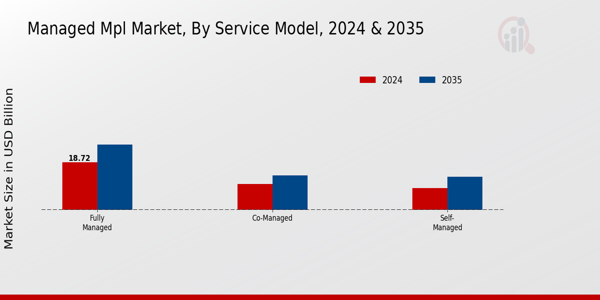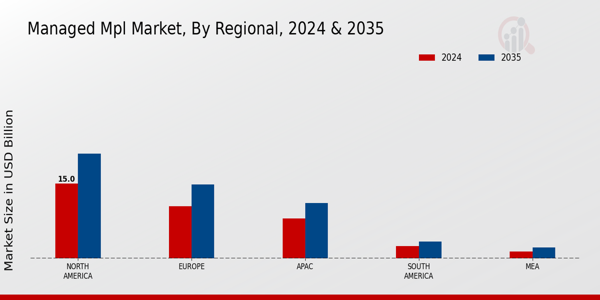Managed MPL Market Overview
The Managed MPL Market Size was estimated at 36.3 (USD Billion) in 2023. The Managed MPL Market is expected to grow from 37.43 (USD Billion) in 2024 to 52.5 (USD Billion) by 2035. The Managed MPL Market CAGR (growth rate) is expected to be around 3.12% during the forecast period (2025 - 2035).
Key Managed MPL Market Trends Highlighted
Advances in technology and growing awareness of network security are driving a substantial change in the global managed MPL market. Companies are depending more and more on managed service providers to guarantee uninterrupted connectivity and improve operational efficiency.Organizations are adopting comprehensive managed network services (MPL) solutions that reduce risks in response to the increasing number of cyber threats, which fuels the demand for safe and dependable managed network services.
Furthermore, the necessity for reliable network solutions that can accommodate a wider range of applications and higher bandwidth requirements has increased due to the shift towards remote work and digital transformation.Opportunities in the Global Managed MPL Market are abundant, particularly as companies look to modernize their IT infrastructure. The integration of cloud services and the Internet of Things is creating new avenues for managed service providers to offer tailored solutions that cater to specific business needs.
Additionally, the expansion of 5G technology presents a unique opportunity for network providers to enhance their offerings and improve service levels. This shift towards automation and analytics in network management is also helping organizations reduce operational costs, providing a further incentive for businesses to adopt managed MPL services.Recent trends show a growing emphasis on enhancing customer experience through improved service delivery and support. Companies are prioritizing partnerships with managed service providers that offer not just connectivity but also value-added services such as analytics and performance monitoring.
The emergence of artificial intelligence and machine learning is transforming how network services are managed, leading to more proactive maintenance and quicker issue resolution. As organizations continue to adapt to changes in the business landscape, the Managed MPL Market is expected to evolve, reflecting the need for more flexible, efficient, and secure network solutions.

Source: Primary Research, Secondary Research, MRFR Database and Analyst Review
Managed MPL Market Drivers
Increased Demand for Network Security and Performance
One of the prominent drivers for the Global Managed MPL Market is the escalating need for enhanced network security and performance among organizations. As cyber threats evolve and become more sophisticated, businesses are increasingly investing in managed services that can provide robust security measures to protect their data and infrastructure.Managed MPL services offer comprehensive solutions, including a variety of security protocols and performance monitoring, ensuring that enterprises can maintain operational continuity even in the face of potential threats.
This demand for security is catalyzed by the growing awareness of potential security breaches, data leaks, and the severe consequences that can follow. The complexity of network environments, especially in multinational corporations, adds layers to security challenges, pushing companies to seek professionally managed services that specialize in MPL (Multiprotocol Label Switching) technology.
These services not only deliver enhanced performance but also ensure that businesses comply with regulations and standards, solidifying their commitment to cybersecurity.As a result, the integration of managed MPL solutions becomes crucial in achieving operational efficiencies while keeping sensitive information secure. Given the increasing reliance on digital operations across industries, the Global Managed MPL Market is poised for growth, driven by this significant demand for network security and performance optimization.
Growth of Cloud Computing and Business Applications
The rise of cloud computing and the proliferation of business applications are pivotal factors driving the Global Managed MPL Market. As more organizations transition to cloud-based models, the need for reliable, high-performance networks becomes paramount.Managed MPL services are ideal in this scenario as they support the efficient delivery of cloud applications, ensuring low latency and high availability. This shift not only enhances productivity but also facilitates innovation as businesses can leverage the benefits of cloud technology without compromising on network performance and reliability.Additionally, the growth in business applications necessitates robust network infrastructures that can handle increased data traffic, making managed MPL services essential for modern enterprises.
Proliferation of IoT Devices
The rapid proliferation of Internet of Things (IoT) devices significantly impacts the Global Managed MPL Market. As more devices come online, the demand for a seamless and efficient networking solution increases, driving the adoption of managed MPL services.These services can effectively manage the complex data streams generated by IoT devices, ensuring optimal performance and security. Furthermore, businesses recognize that an efficiently managed MPL setup is crucial for enabling their IoT strategies, which in turn fosters innovation and operational efficiency.
Managed MPL Market Segment Insights
Managed MPL Market Service Model Insights
The Global Managed MPL Market served a growing demand for efficient network management solutions through its various service models.Within this framework, the Fully Managed service model emerged as a significant contributor, projected to account for a valuation of 18.72 USD Billion in 2024 and expected to reach 25.75 USD Billion by 2035.
This sub-segment dominated the market due to its comprehensive nature, which allowed businesses to rely on third-party providers for all aspects of their MPL services, thus freeing internal resources and enhancing operational efficiency.Following this, the Co-Managed model held a substantial position, with a valuation of 10.12 USD Billion in 2024, climbing to 13.65 USD Billion by 2035. This model became increasingly popular as organizations sought a balance between outsourcing and retaining control over certain network functions.
The Co-Managed approach empowered businesses by enabling them to collaborate with service providers, enhancing flexibility and customizing solutions to meet specific requirements.Meanwhile, the Self-Managed segment, valued at 8.59 USD Billion in 2024 and projected to increase to 13.1 USD Billion in 2035, represented a sector where companies prefer handling their network management internally.
While this model reflected a commitment to maintaining in-house expertise, it generally attracted a smaller market share due to the growing complexity of network management and the increasing reliance on advanced third-party solutions.The insights revealed that businesses are progressively gravitating toward Managed MPL services that drive efficiency and optimization in operations, with the Fully Managed model holding a majority stake in the market.The continued advances in technology and networking capabilities presented opportunities for enhancing service delivery within these models, affirming a strong trajectory toward a consolidated growth landscape for the Global Managed MPL Market.
This segmentation illustrated the diverse strategies adopted by organizations in managing their MPL services and underlined the substantial investment opportunities available within this industry. Overall, the Global Managed MPL Market statistics showcased a dynamic environment that continues to evolve, reflecting the growing need for tailored network solutions across varying operational frameworks.

Source: Primary Research, Secondary Research, MRFR Database and Analyst Review
Managed MPL Market Deployment Type Insights
The Global Managed MPL Market is structured around various deployment types, which play a crucial role in determining service delivery and operational efficiency. Each deployment type, including On-Premises, Cloud-Based, and Hybrid, offers distinct advantages and is tailored to meet different business needs.On-premises solutions are often prioritized by organizations prioritizing data security and control, while Cloud-Based options provide flexibility and scalability, making them popular among small to medium-sized enterprises.
The Hybrid approach, combining elements of both, caters to businesses seeking a balanced model that can adapt to changing demands. This diversity in deployment types reflects the varying market requirements and preferences, highlighting significant growth in the Global Managed MPL Market.Trends indicate a shift towards more adaptive models that facilitate remote work and cloud integration, while growth drivers include increased digitalization and the rising need for efficient managed services. As organizations continue to navigate these complexities, the insights from Global Managed MPL Market data will be imperative for informed decision-making.
Managed MPL Market End Use Industry Insights
The Global Managed MPL Market is projected to show substantial growth through various End Use Industries, reflecting diverse demand dynamics. The significant contribution from the telecommunications sector highlights its essential role in the adoption of managed MPL services, driven by the increasing demand for connectivity and robust networking solutions.
Healthcare is also critical, with a growing need for secure and reliable data transfer owing to the rise in telehealth services and digital record management. In finance, the urgency for secure transaction processing enhances the relevance of managed MPL solutions, while the manufacturing industry increasingly relies on these services for operational efficiency and automation.
Retail, meanwhile, sees managed MPL as integral for enhancing customer experiences and streamlining supply chain management. These insights into Global Managed MPL Market segmentation illustrate that each sector faces unique challenges and opportunities, creating a versatile landscape for growth fueled by increasing digital transformation and technological advancements.
Managed MPL Market Network Type Insights
Within this industry, the Network Type segment plays a crucial role in shaping market dynamics. The segmentation primarily includes MPLS, VPN, and SD-WAN, each serving unique functions and customer needs.MPLS continues to dominate the market due to its reliable performance and efficient traffic management, making it a favored choice for businesses seeking robust connectivity. VPN solutions are significant as they offer secure remote access, a necessity in the current digital landscape where remote work is prevalent.
Meanwhile, SD-WAN is emerging as a vital player due to its flexibility and cost-effectiveness, appealing particularly to organizations looking to optimize their network infrastructures. The increasing reliance on cloud services and the need for secure, efficient connectivity are driving growth in these segments.The Global Managed MPL Market revenue reflects these trends, highlighting a shift towards integrated network solutions that leverage the strengths of MPLS, VPN, and SD-WAN technologies. Overall, the segment showcases an evolving landscape with ample opportunities for innovation and expansion as businesses adapt to changing technological needs.
Managed MPL Market Regional Insights
The Global Managed MPL Market exhibited significant variation across regional segments, with North America leading in overall valuation at 15.0 USD Billion in 2024, projected to reach 21.0 USD Billion by 2035, thus holding a majority share of the market.Europe followed closely, valued at 10.5 USD Billion in 2024 and expected to grow to 14.8 USD Billion by 2035, indicating its importance in the global landscape. The APAC region accounted for a substantial portion as well, with a market value of 8.0 USD Billion in 2024, growing to 11.1 USD Billion by 2035, driven by rapid technological advancements and increasing demand.
South America and MEA represented smaller segments, valued at 2.5 USD Billion and 1.43 USD Billion respectively in 2024, but their growth potentially offered unique opportunities for market expansion, reaching 3.4 USD Billion and 2.2 USD Billion by 2035.The diversity in the Global Managed MPL Market segmentation illustrated varied growth drivers, challenges, and opportunities across regions, highlighting the importance of tailoring strategies to capture the dynamics of each area within the market aligning with the overall Global Managed MPL Market data and statistics.

Source: Primary Research, Secondary Research, MRFR Database and Analyst Review
Managed MPL Market Key Players and Competitive Insights
The Global Managed MPL Market is witnessing significant growth as organizations increasingly rely on managed service providers to deliver robust network performance and enhanced connectivity solutions. Competitive insights within this market reveal an ongoing evolution characterized by technological advancements, shifts in customer requirements, and aggressive competition among service providers.As companies aim to optimize their network infrastructure and improve operational efficiencies, the demand for managed MPL services is projected to increase.
Market players are focused on innovative solutions that encompass scalability, security, and reliability, ultimately shaping the competitive landscape and defining strategic partnerships. The landscape is dynamic, with established firms leveraging their strengths and new entrants challenging them through creative offerings and competitive pricing strategies.In the Global Managed MPL Market, NTT Data demonstrates a strong presence and a comprehensive suite of managed services tailored to meet diverse client needs. The company's commitment to innovation and technology empowers it to deliver high-performance networking solutions, which are crucial for businesses seeking seamless connectivity.
NTT Data's strengths lie in its robust infrastructure capabilities, deep industry expertise, and a comprehensive understanding of customer requirements. By focusing on customized solutions and proactive network management, NTT Data is able to enhance operational efficiency while minimizing risks associated with network downtime.Its global reach enables it to effectively serve multinational clients, providing localized support alongside a consistent service delivery model. The combination of these strengths positions NTT Data as a formidable player in the managed MPL landscape, enhancing its competitiveness.
Accenture boasts a strong foothold in the Global Managed MPL Market, recognized for its comprehensive approach to addressing the complexities of modern networking. By leveraging cutting-edge technologies and analytics, Accenture provides clients with tailored, managed MPL services that enhance agility and responsiveness to changing market conditions.The company's strengths lie in its extensive consulting capabilities, enabling it to not only deliver managed services but also to advise clients on digital transformation journeys. This dual focus on strategy and execution allows Accenture to forge lasting partnerships with clients, ensuring that managed MPL solutions align with broader organizational goals.
Furthermore, Accenture's investment in innovation and continuous improvement allows it to stay ahead of industry trends, providing clients with future-proof solutions that support their evolving networking needs. This positions Accenture as a competitive force within the managed MPL sector, appealing to organizations looking for comprehensive support in their network management strategies.
Key Companies in the Managed MPL Market Include
- NTT Data
- Accenture
- IBM
- Verizon
- Orange Business Services
- Dimension Data
- Fujitsu
- Capgemini
- AT and T
- Infosys
- Hewlett Packard Enterprise
- Dell Technologies
- Cisco Systems
- Wipro
- Tata Consultancy Services
Managed MPL Market Developments
Recent developments in the Global Managed MPL Market have showcased significant growth driven by increasing demand for efficient data management solutions and enhanced connectivity. Companies such as NTT Data, Accenture, and IBM are actively expanding their service portfolios to address emerging customer needs.Verizon and Orange Business Services are investing in next-generation networking infrastructure, which is fueling competitive dynamics. Meanwhile, Dimension Data and Fujitsu continue to enhance their MPL services by integrating advanced analytics and artificial intelligence to optimize network performance.
Notably, Capgemini and AT&T recently announced a collaborative effort to enhance cloud-based managed MPL services, reflecting a strategic move toward innovation.Wipro, Tata Consultancy Services, and Infosys are leveraging partnerships to expand their global footprint in the managed services landscape, while Dell Technologies and Cisco Systems are focusing on creating robust security frameworks within their MPL offerings.Recent mergers and acquisitions are shaping the market, with companies looking to bolster their technological capabilities and service delivery platforms to capture a more significant market share. This evolving landscape illustrates an increasing emphasis on collaboration and technological integration in the Global Managed MPL Market.
Managed MPL Market Segmentation Insights
Managed MPL Market Service Model Outlook
- Fully Managed
- Co-Managed
- Self-Managed
Managed MPL Market Deployment Type Outlook
- On-Premises
- Cloud-Based
- Hybrid
Managed MPL Market End Use Industry Outlook
- Telecommunications
- Healthcare
- Finance
- Manufacturing
- Retail
Managed MPL Market Network Type Outlook
Managed MPL Market Regional Outlook
- North America
- Europe
- South America
- Asia Pacific
- Middle East and Africa
|
Report Attribute/Metric
|
Details
|
|
Market Size 2023
|
36.3(USD Billion)
|
|
Market Size 2024
|
37.43(USD Billion)
|
|
Market Size 2035
|
52.5(USD Billion)
|
|
Compound Annual Growth Rate (CAGR)
|
3.12% (2025 - 2035)
|
|
Report Coverage
|
Revenue Forecast, Competitive Landscape, Growth Factors, and Trends
|
|
Base Year
|
2024
|
|
Market Forecast Period
|
2025 - 2035
|
|
Historical Data
|
2019 - 2024
|
|
Market Forecast Units
|
USD Billion
|
|
Key Companies Profiled
|
NTT Data, Accenture, IBM, Verizon, Orange Business Services, Dimension Data, Fujitsu, Capgemini, AT and T, Infosys, Hewlett Packard Enterprise, Dell Technologies, Cisco Systems, Wipro, Tata Consultancy Services
|
|
Segments Covered
|
Service Model, Deployment Type, End Use Industry, Network Type, Regional
|
|
Key Market Opportunities
|
Increased demand for secure connectivity, Adoption of cloud-based services, Growth in remote work solutions, Rise in IoT applications, and Enhanced network performance requirements.
|
|
Key Market Dynamics
|
growing demand for network scalability, increasing adoption of cloud services, focus on cost reduction, rising cybersecurity threats, need for reliable connectivity
|
|
Countries Covered
|
North America, Europe, APAC, South America, MEA
|
Frequently Asked Questions (FAQ) :
The Global Managed MPL Market is expected to be valued at 37.43 USD Billion in 2024.
By 2035, the Global Managed MPL Market is projected to reach a value of 52.5 USD Billion.
The expected CAGR for the Global Managed MPL Market from 2025 to 2035 is 3.12%.
North America is expected to dominate the Global Managed MPL Market in 2024, valued at 15.0 USD Billion.
The North American market for Global Managed MPL is projected to grow to 21.0 USD Billion by 2035.
The Fully Managed segment of the Global Managed MPL Market is expected to be valued at 25.75 USD Billion in 2035.
Major players in the Global Managed MPL Market include NTT Data, Accenture, IBM, and Verizon.
The Co-Managed segment is anticipated to reach a value of 13.65 USD Billion by 2035.
The projected market size for the APAC region in 2024 is 8.0 USD Billion.
The Self-Managed segment is expected to achieve a value of 13.1 USD Billion by 2035.

















